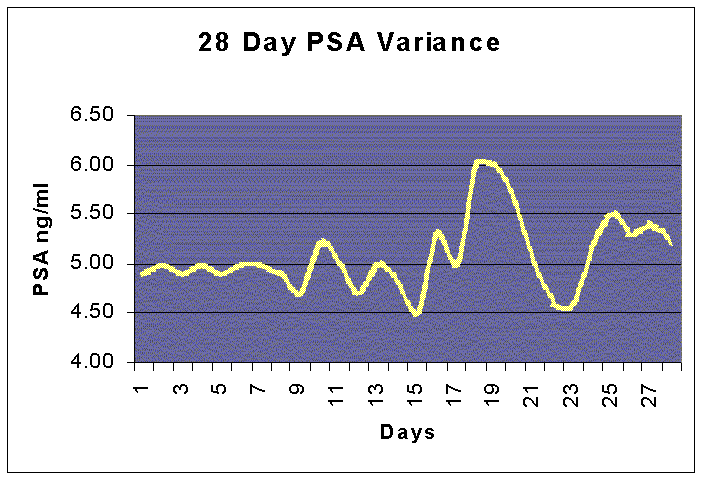Figure
2 - Chart of results of 28 day PSA experiment
There
was some discussion about this experiment and one of the medical men on the List
had this to say:
"Day-to-day as well as monthly fluctuations of some biological parameters
are a fact are reported on salivary testosterone and cortisol, among others. It
seems that a number of interacting factors would trigger similar fluctuations
on blood PSA. Your experiment would tend to prove, rather than disprove, the value
of PSA testing, as your results fluctuated within a relatively limited range.
It would point out, however, to the advisability of repeat tests in borderline
situations."
Note
the comment that the range of the PSA numbers - from 4.50 ng/ml to 6.00 ng/ml
- is regarded as relatively limited. This should be borne in mind for those marginal
increases that cause so much bother to some men.
In
2007, one of the members of the PPML Mailing List analysed the figures in a different
way and it may be of interest to see his take, which is on The
Palpable Prostate blog at PSA
Variation
Another
issue that comes out of these figures is the question of PSA velocity, or doubling
time. There are studies that relate speed of increase in PSA to aggressiveness
and progression of disease, despite the fact that PSA is not prostate cancer specific.
A doubling time measured in weeks or months is regarded as very dangerous, while
a doubling time measure in years is regarded as somewhat better. It is also said
that a velocity annual increase greater than 0.75 ng/ml is cause for concern.
An
increase, as my tests in this experiment showed, from 4.50 ng/ml to 6.00 ng/ml
in three days indicates an estimated doubling time of only 9 days and would also
represent an increase double that regarded as 'safe' for an annual velocity increase,
let alone one over three days.
Looking
at all the figures in this experiment and using them to calculate a doubling time,
produced an estimate of 229 days - a little under 8 months. Somewhat better than
9 days but still dangerously rapid and a clear call to action. Yet
my PSA did not double in 9 days. It did not double in 229 days. In September 2003,
two years plus since this experiment, my PSA went from the median of 5.00 ng/ml
at that time to 6.25 ng/ml, well within the 'safe' figure of 0.75 ng/ml per annum.
In
January 2005, after I had a TURP (Trans Urethral Resection of the Prostate) my
PSA was 12.99 and it continued to rise after that. Details of what I decided to
do are in my story.



